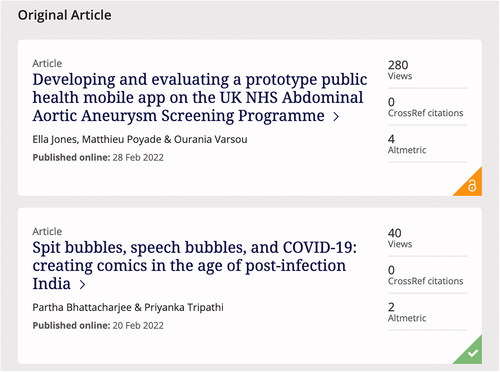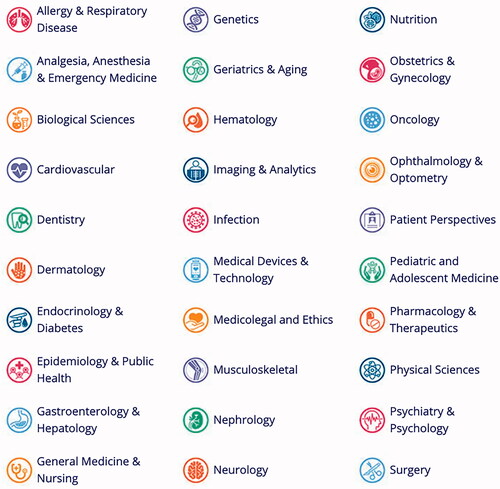Abstract
As members of the Institute of Medical Illustrators (IMI), we have access to the Journal of Visual Communication in Medicine when we log into the website but many other resources that might be useful for our learning and continuing professional development (CPD) are not as readily available and may be behind pay walls. We cannot become a member of every organisation and health regions may allow access to some but not all journals. Open access means that some books, articles and journals can be accessed by anyone, rather than having to have a subscription to access them. The aim of this article is to look at some of the benefits of open access for the CPD of medical illustrators including where open access resources can be found to support personal and professional development.
The open access movement
The objective of the open access movement which began in the 1990s (Tennant et al., Citation2016) was to improve the systems of scientific communication by optimising access to research outputs and so maximising the impact of research results, so that by making publications freely accessible research could be read more widely and cited more often (Oakley & Vaughan, Citation2022) and in the case of practice based research disseminated and implemented more quickly. Further background to open access is available online for example in Wikipedia (Citation2022) (https://en.wikipedia.org/wiki/Open_access). A useful video which covers the different models for open access can be found on YouTube (phdcomics, Citation2012) and further information through the Joint Information Systems Committee (JISC, Citation2019).
The benefits of open access
Open access is beneficial for medical illustrators in developing countries or in institutions with limited access to subscription journals. Open access articles also attract more citations, i.e. mentions by other authors in their papers (Lawrence, Citation2001) as well as having other advantages (Langham-Putrow et al., Citation2021).
From an author’s perspective, a benefit of open access is that they can send out the digital object identifier (DOI) for an article and anyone can access it to read and download not just IMI members. An example of a DOI is this link from an article published recently (Bryson, Citation2022) doi/full/10.1080/17453054.2021.2005459. This means that if you see an open access article that you think may be of interest to a friend or colleague who is not an IMI member when you send them the link they can freely access and download it.
Digital object identifiers are used to identify academic publications using a string of numbers, letters and symbols to uniquely identify an article or document so providing it with a permanent web address with a unique resource locator (URL) (Paskin, Citation2005). A DOI helps readers to easily locate a document from your citations and is recommended to be used for references in this Journal.
The Journal of Visual Communication in Medicine and open access articles
The journal now includes an open access option for article publication. These can have open access as the author’s organisation either pays for open access or has an arrangement with Taylor and Francis who publish the journal or alternatively, the editors may make an article open access if it is considered useful for wider dissemination and to support or promote the journal.
From the journal’s main page, there is a link to open access articles, see .
Figure 1. The open lock in the orange triangle indicates that the paper is open access. The green tick indicates access as a member of IMI (https://www.tandfonline.com/action/showOpenAccess?journalCode=ijau20).

Learning activity: try using open access publications and articles when you next need to find out more about a topic to support your CPD
We have all been there had a great idea and gone onto scholar (https://scholar.google.co.uk/) or other databases to search for useful references but only been able to read the abstract without the journal asking for money or finding your organisation does not subscribe to that journal. So instead have a go at searching using the open access resources like the directory of open access journals (DOAJ) then you will be searching directly for things you know you and others can read and save finding papers that are useful but being unable to read them. Another useful resource is https://unpaywall.org/, unpaywall finds free versions of papers behind paywalls and also provides a browser extension (Chawla, Citation2017).
The DOAJ https://doaj.org/ was launched in 2003 with 300 open access journals. Today, this independent index contains almost 17,500 peer-reviewed, open access journals covering all areas of science, technology, medicine, social sciences, arts and humanities. The search function allows you to find papers to read and use in your work and research without coming up against pay walls.
Many universities have institutional repositories where staff upload their work you will often see these links along with those to academia.edu and researchgate.net when searching for papers using Google scholar. More about academics’ experiences of open access can be seen at SUNY CPD Videos (Citation2021) and information about business models for open access books in Folan (Citation2022).
Learning activity: developing a resource collection
First, learn more about the possibilities of open access
Take time to watch and reflect on the online resources available for example What is open access? (SHB Online, Citation2019). Look at using open access journals and books rather than buying expensive medical textbooks for your CPD. Many medical journals and books are now published as open access saving you and your department money and enabling wider access to all staff for sharing.
Second, think about developing a collection of resources in your specialist area of expertise to support your colleagues’ and fellow medical illustrators’ CPD using open access materials so your efforts can be disseminated and shared more widely. For example, look at the subject areas covered by Dove Medical Press, see .
Figure 2. Journals by subject area from Dove Medical Press (https://www.tandfonline.com/openaccess/dove).

There is also a directory of open access books (DOAB) at https://www.doabooks.org/en
All books listed in DOAB are freely accessible and therefore free to read, but this does not mean readers are free to do anything they like with these books. The usage rights of the books in DOAB are determined by the licence. Do check any licences if you want to re-use the contents of a book. Generally speaking, all books listed in DOAB are free to read and share for non-commercial use.
Disclosure statement
No potential conflict of interest was reported by the author(s).
References
- Bryson, D. (2022). Continuing professional development and mentoring. Journal of Visual Communication in Medicine, 45, 64–66. doi:10.1080/17453054.2021.2005459
- Chawla, D.S. (2017). Unpaywall finds free versions of paywalled papers. Nature. https://www.nature.com/articles/nature.2017.21765.pdf?origin=ppub
- Folan, B. (2022). Webinar – Business models for Open Access Books: A compendium. OASPA. https://oaspa.org/webinar-business-models-for-open-access-books-a-compendium/
- JISC. (2019). An introduction to open access. https://www.jisc.ac.uk/guides/an-introduction-to-open-access
- Langham-Putrow, A., Bakker, C., & Riegelman, A. (2021). Is the open access citation advantage real? A systematic review of the citation of open access and subscription-based articles. PLOS One, 16, e0253129. doi:10.1371/journal.pone.0253129
- Lawrence, S. (2001). Free online availability substantially increases a paper’s impact. Nature, 411, 521. doi:10.1038/35079151
- Oakley, S., & Vaughan, J. (2022). Open access movement. Higher education libraries. https://www.sciencedirect.com/topics/computer-science/open-access-movement
- Paskin, N. (2005). Digital object identifiers for scientific data. Data Science Journal, 4, 12–20. doi:10.2481/dsj.4.12
- phdcomics. (2012). Open access explained! YouTube. https://www.youtube.com/watch?v=L5rVH1KGBCY
- SHB Online. (2019). What is open access? YouTube. https://www.youtube.com/watch?v=Ne8kTJ0-fEM&t=0s
- SUNY CPD Videos. (2021). Open Access Publishing and University Research. YouTube. https://www.youtube.com/watch?v=rSEbK2Pp3mk
- Tennant, J.P., Waldner, F., Jacques, D.C., Masuzzo, P., Collister, L.B., & Hartgerink, C.H. (2016). The academic, economic and societal impacts of Open Access: An evidence-based review. F1000Research, 5, 632. doi:10.12688/f1000research.8460.3
- Wikipedia. (2022). Open access. Wikipedia. https://en.wikipedia.org/wiki/Open_access
